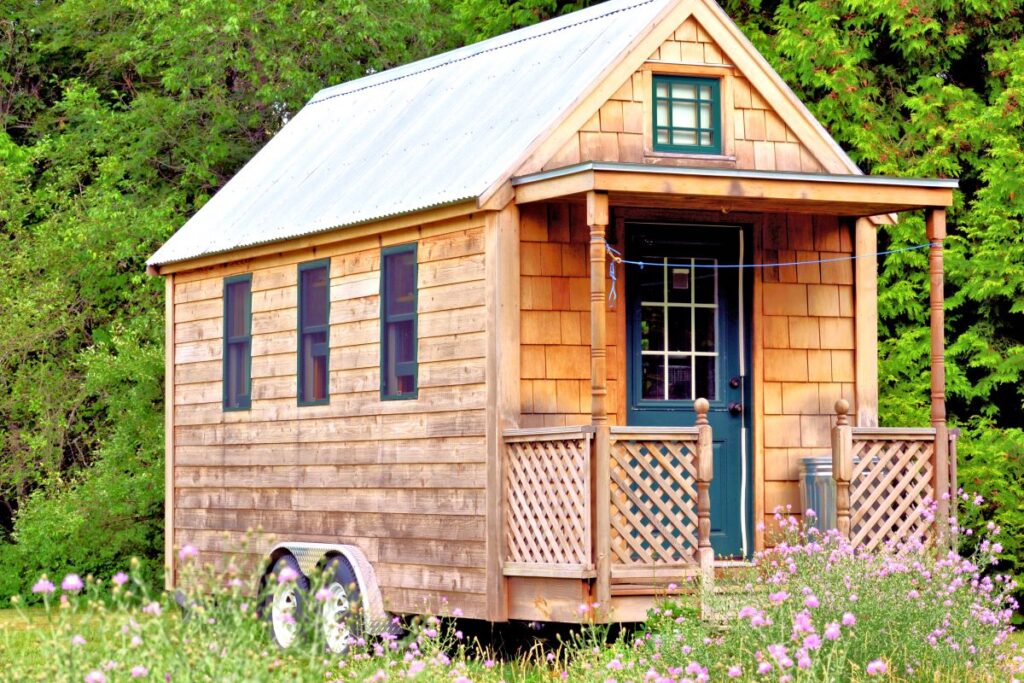In recent decades, more and more people have been interested in tiny homes as an alternative to traditional housing. These small homes appeal to those who want to live a simpler life and reduce their environmental impact because of their small size and basic design. However, some people have raised concerns about whether these homes are really sustainable or just a passing trend.
Tiny houses are sustainable if planned and constructed using environmentally friendly materials and energy-saving features. The sustainability of small dwellings, however, also partly relies on the way of life of those living there.
Read on to learn more about the numerous sustainability factors of tiny homes to see whether they actually live up to their reputation as green living solutions.
Quick Navigation
- Environmental Impact of Traditional Homes
- Benefits of Tiny Homes for Sustainability
- Challenges to Sustainability in Tiny Home Living
- Pros of Living in a Tiny Home
- Cons of Living in a Tiny Home
- Balancing the Pros and Cons of Tiny House Living for Sustainability
- Conclusion
Environmental Impact of Traditional Homes
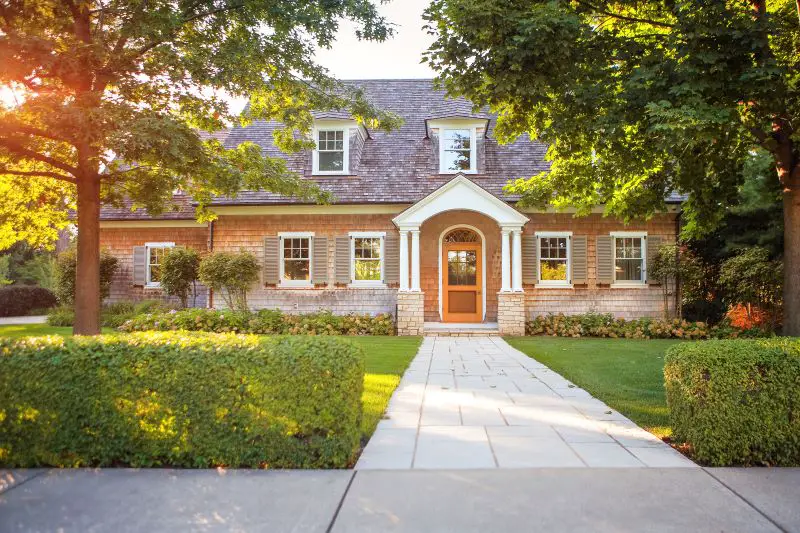
The environment is significantly impacted by traditional housing. From the construction phase to daily living, these homes contribute to climate change, resource depletion, and pollution.
Increased carbon footprint
Due to several variables, such as their bigger size, higher energy usage, and use of resources during construction, traditional dwellings have a substantially higher carbon footprint than tiny homes.
A typical home requires a significant amount of raw materials, including steel, concrete, and timber, the extraction and processing of which may have a detrimental environmental effect.
Since traditional homes are often larger than tiny houses, building them requires more resources and building materials, which increases their footprint.
Yet, conventional homes often use more energy than tiny houses due to their larger size and less efficient design. As a result, there will be a more critical requirement for heating and cooling and more extensive equipment and technology.
Increasing energy demand causes power plants that produce electricity to emit more carbon dioxide into the atmosphere, contributing to global warming.
High energy consumption
Due to their bigger size, inefficient construction, and usage of appliances and gadgets, traditional dwellings consume more energy than compact ones.
More dependence on fossil fuel-powered energy sources and higher energy bills may result from larger houses’ higher heating and cooling energy requirements.
However, traditional houses sometimes need more efficient design elements, such as drafty windows and inadequate insulation, which may result in energy loss and increased utility costs.
Also shared in traditional homes are larger appliances, devices like refrigerators, washers, and dryers, as well as home entertainment systems.
These appliances and gadgets use a lot of energy, which increases energy prices and carbon emissions.
Homeowners may take several actions to lower the energy usage of classic houses.
They may, for instance, put in energy-saving gadgets and appliances like refrigerators, washers, and dryers with the Energy Star label.
They may also increase their home’s insulation and fix any air leaks to lower their heating and cooling costs.
Material waste and overconsumption
Overconsumption and material waste are severe problems in traditional dwellings. A typical house needs many raw materials, such as lumber, concrete, and steel, whose extraction and processing may harm the environment.
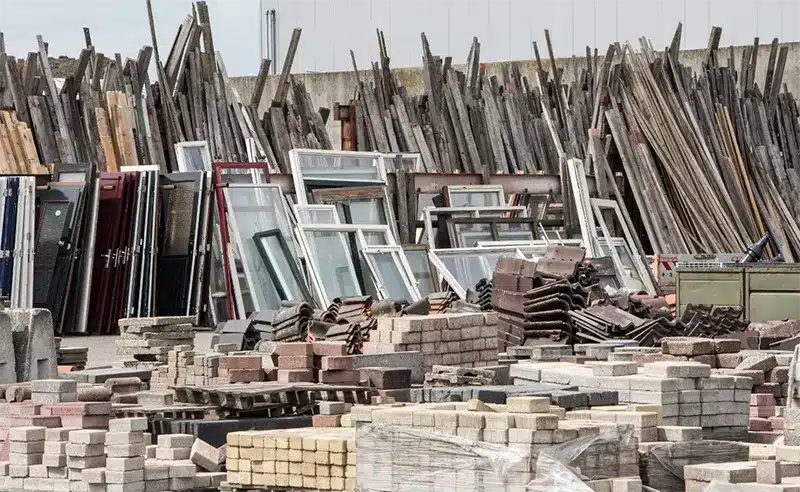
Moreover, traditional houses often use more resources than required during building and occupation, since they are more significant than needed.
While additional room necessitates heating and cooling, this excessive size adds to energy waste and higher utility costs.
However, typical houses often include elements that could be more environmentally friendly, such as single-use plastics, high-flow showerheads, and ineffective appliances.
These decisions can seem small on their own, but when taken together by a whole household and population, they can significantly influence the environment.
It is crucial to reconsider our housing approach and prioritize sustainability throughout the design and building process to address these problems.
This may include using eco-friendly materials, building smaller dwellings, and adding sustainable elements like solar power, rainwater collection systems, and sustainable plumbing system.
Benefits of Tiny Homes for Sustainability
A growing number of people are choosing to join the tiny house movement to lessen their influence on the environment.
The environment gains from these modest living areas, including less trash creation, and a lower footprint.
Reduced carbon footprint
Due to their smaller size and lower energy use, tiny homes have far less carbon impact than conventional residences.
Tiny dwellings aid in reducing greenhouse gas emissions and climate change by using fewer resources and needing less electricity for heating and cooling.
Lower energy consumption
Tiny houses are getting increasingly popular because of their compact size, low cost, and environmental friendliness.
Small dwellings use less energy than conventional homes. Following are some strategies used by tiny houses to achieve this:
Smaller size: The most significant advantage of tiny houses is their size. Most tiny houses typically range from 100 to 400 square feet, whereas traditional homes average around 2,600 square feet. A smaller home requires less energy to heat and light.
Better insulation: Tiny homes are often designed with high-quality insulation to maximize energy efficiency. With proper insulation, tiny houses can retain heat in the winter and stay cool in the summer without relying heavily on heating and cooling systems.
Energy-efficient appliances: Tiny homes use smaller, more energy-efficient appliances explicitly designed for smaller spaces. This includes refrigerators, heaters, air conditioners, and lighting fixtures.
Renewable energy sources: Many tiny homes rely on renewable sources like solar panels or wind turbines. These systems can provide enough power to run the home without relying on the electrical grid.
Natural light: Tiny homes are designed to maximize natural light, reducing the need for artificial lighting during the day.
Reduced material use
Reduced material use is another benefit of tiny homes. By design, tiny homes require less material to build and furnish than traditional homes.
Tiny homes are significantly smaller than traditional homes, requiring fewer building materials. For example, a tiny house may only need one or two drywall sheets, whereas a more prominent home may need dozens.
Because space is at a premium in tiny homes, they often incorporate vertical storage solutions such as built-in shelves or wall-mounted storage units. This reduces the need for bulky furniture pieces like dressers or cabinets.
Many tiny homes incorporate minimalist design principles, which means they have fewer decorative features or unnecessary details. This reduces the need for additional building materials and can create a more streamlined, modern look.
Use of sustainable materials
Many tiny homes are also designed with sustainable materials, such as bamboo and recycled materials, reducing their environmental impact.
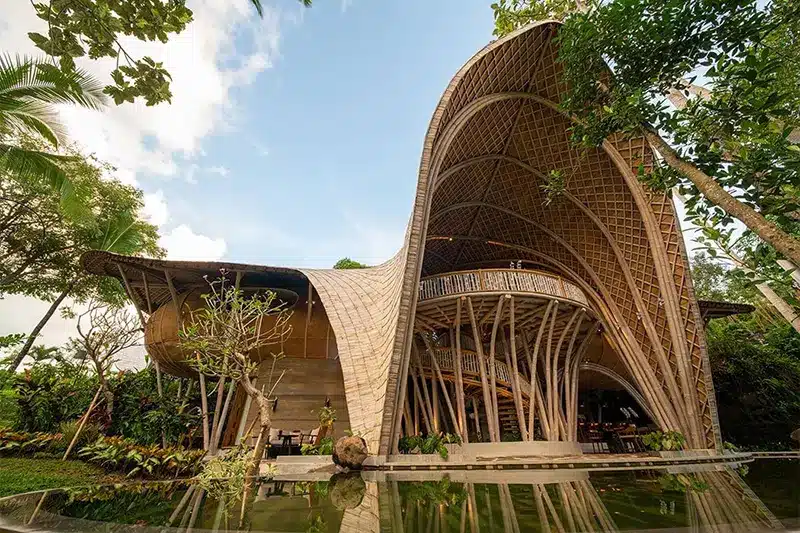
Tiny homes promote sustainability using eco-friendly materials and provide an example of environmentally conscious design.
See below for the average difference in carbon footprint, material use, and cost of a tiny home vs. a traditional home.
| Type of Home | Average Carbon Footprint | Average Material Use | Average Cost |
| Tiny Homes | 2-4 metric tons per year | Significantly less material to cater average of 400 square feet | Around $23,000-$35,000 |
| Traditional Homes | 13.3 metric tons per year | More materials to cater to the average 2,600 square feet | Around $375,000 |
Challenges to Sustainability in Tiny Home Living
While tiny homes, such as container homes, offer many benefits for sustainability, they also present several challenges that must be addressed to ensure their long-term viability.
In this section, we will explore some of the challenges to sustainability in tiny living and potential solutions.
Waste management
Waste management is essential to sustainable living, and tiny living is no exception. It is crucial to manage trash effectively to minimize the environmental impact and preserve a clean and pleasant living environment in an area with limited resources and small space.
Adopting a zero-waste lifestyle is one strategy for managing waste while living in a tiny house. This entails eliminating single-use plastics, choosing items with less packaging, and composting.
Composting is an efficient approach to reducing the quantity of organic waste generated by transforming organic waste into fertile soil for farming and gardening.
Recycling should be prioritized as another strategy to control trash in compact homes. Recyclables like glass, plastic, and paper must be separated from other trash and disposed of correctly in designated recycling containers.
Properly disposing of hazardous garbage, including batteries and electronics, is critical. Finding nearby recycling or disposal facilities that accept these items and adhering to their safe and responsible disposal instructions are required.
Energy sources
Living in a small house requires careful consideration of energy sources because of the home’s restricted size and resource availability.
Traditional grid electricity, renewable sources, and off-grid choices are some of the ways to power a tiny house.

Traditional grid energy, which connects the house to a power grid through a utility company, is famous for powering a small home.
This is a dependable and practical choice, but since it often depends on fossil fuels to produce energy, it may not be the most economical or ecological alternative.
Living in tiny houses is becoming increasingly common, and popular renewable sources include solar and wind power.
A small house may be outfitted with solar panels for electricity production from the sun, and it can also be powered by wind using wind turbines.
These options appeal to tiny house residents wanting a more independent lifestyle since they are cost-effective, sustainable, and off-grid.
Off-grid options include supplying a little house with energy without tying it into the primary grid.
You may combine alternative heating and cooking methods like propane or wood stoves with sustainable energy sources like solar and wind power.
These options may provide a sustainable and independent existence for people looking to live off the grid, but they need careful planning and administration.
Accessibility
Finally, tiny home living faces challenges related to accessibility. Many municipalities have zoning and building regulations that make a living legally in a tiny home difficult. Land ownership can be challenging for those seeking to live sustainably in a tiny home.
To address these challenges, tiny house owners could work to educate policymakers and the public about the benefits of sustainable living and promote changes in zoning and building regulations that support the development of tiny house communities.
Overall, while tiny houses present challenges to sustainability, they also offer a promising model for a more sustainable future.
By working together to address waste management, find sustainable energy sources, and promote accessibility, tiny home communities can help pave the way for a more sustainable world.
Pros of Living in a Tiny Home
Tiny homes have gained popularity recently as a way to live sustainably, but they offer many other benefits beyond their environmental impact.
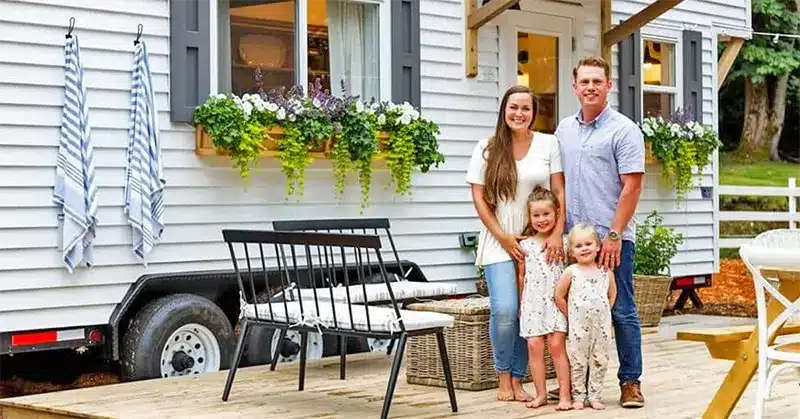
Here are the various advantages of living in a tiny home.
Energy efficiency: Tiny houses are designed to save energy, with many incorporating features like solar panels and energy-efficient appliances.
By using less resources for heating and cooling, tiny homes significantly reduce electric consumption and contribute to a more sustainable future.
Lower carbon footprint: Due to their smaller house size and reduced energy consumption, tiny houses have a significantly smaller footprint than traditional homes.
Tiny homes help combat climate change and promote a more sustainable world as they require fewer materials, contributing less to greenhouse gas emissions.
Reduced material consumption: Tiny homes promote a minimalist lifestyle, which can lead to reduced use of materials and a lower environmental impact.
With less space for storage, tiny homeowners must be intentional about their consumption patterns and often choose to live with fewer material possessions.
This intentional consumption leads to less waste and reduces the demand for new resources.
Affordable living: Modern tiny house movement offers affordable housing options for many people, with lower upfront costs and ongoing expenses.
Additionally, tiny houses often have more environmental benefits, leading to lower utility bills and reduced maintenance costs.
By simplifying life and reducing expenses, tiny houses offer a promising option for those seeking to live sustainably on a budget.
A tiny home offers many advantages, from energy efficiency to affordable living. By promoting intentional consumption, minimalism, and sustainable living, tiny homes provide a promising model for a more sustainable and fulfilling way of life.
Cons of Living in a Tiny Home
While tiny homes offer many benefits, they also present several challenges that must be considered before committing to the lifestyle.
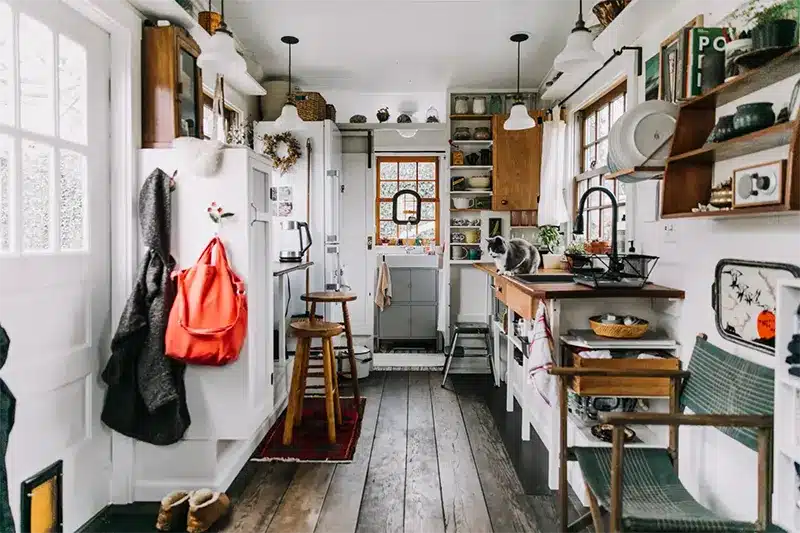
Let’s explore some of the cons of living in a tiny home.
Limited living space: The most obvious downside of tiny houses is the limited living space. While tiny homes are designed to be efficient and functional, they can still feel cramped, especially for those used to more space.
The lack of privacy and personal space can also be challenging for tiny house dwellers.
Lack of storage space: Another challenge of tiny home living is more storage space. With limited square footage, finding a place for all your belongings can take time and effort.
This can lead to a need for constant decluttering and minimalism, which may need to be more appealing and practical for everyone.
Zoning and building code challenges: Tiny home living faces zoning and building codes challenges. In fact, there are worst states for tiny homes that make tiny living difficult.
This can be a significant barrier for those seeking to embrace a more sustainable and affordable way of living.
Social isolation: Living in a tiny home can be socially isolating, primarily if the home is located in a remote area or has limited community engagement.
While tiny home communities are emerging, they are still relatively rare, which can challenge those seeking a sense of community and social interaction.
Overall, while tiny houses offer many benefits, they also present several challenges that must be considered before deciding to downsize.
By considering space and storage limitations, navigating zoning and building code challenges, and seeking out community connections, those committed to sustainable and minimalist living can succeed in tiny home living.
You might also be interested to learn about how long does it take to sell a tiny home.
Balancing the Pros and Cons of Tiny House Living for Sustainability
While they are becoming increasingly well-liked as a method to live more sustainably, tiny houses are not without their difficulties.
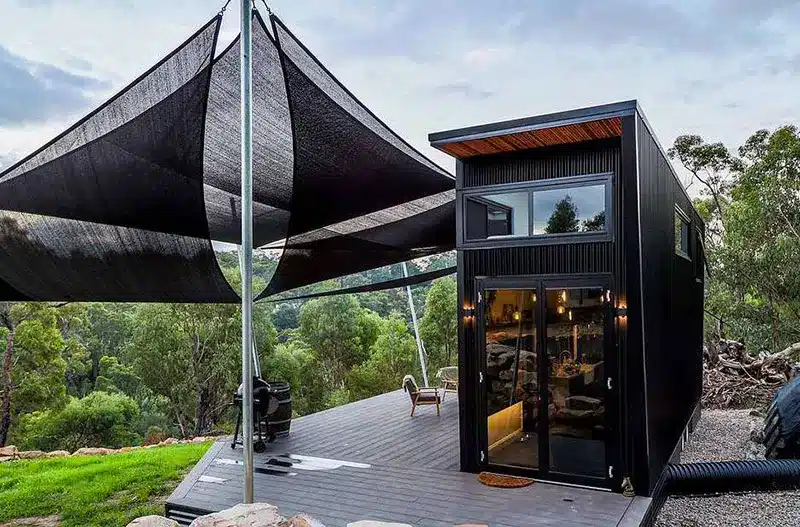
To ensure that sustainable living is possible but also valuable and satisfying, weighing the benefits and drawbacks of tiny home living is crucial.
Tiny houses are an eco-friendly choice that may support a more sustainable way of living, since they have a lower carbon footprint and require fewer materials.
Also, tiny houses provide financial flexibility, and less maintenance and upkeep, which makes them a desirable alternative for individuals wanting a more straightforward way of life.
However, tiny home living presents challenges such as space and storage constraints, zoning and building code challenges, and social isolation.
To ensure that tiny home living is viable, it is vital to balance the pros and cons and consider the challenges carefully.
Despite the challenges, tiny houses remain a sustainable, affordable, and attractive housing option for those committed to minimalist living and a greener future.
Conclusion
As a result, individuals looking for simpler and sustainable living have a unique and alluring alternative in tiny homes.
Although they may not be appropriate for everyone, they have the potential to lessen our environmental impact, preserve resources, and increase the availability of affordable housing.
Yet ultimately, the sustainability of small dwellings relies on the decisions taken about their design, selection of materials, and energy consumption.
It is crucial to carefully evaluate the environmental effect and long-term sustainability, just like any dwelling option.

